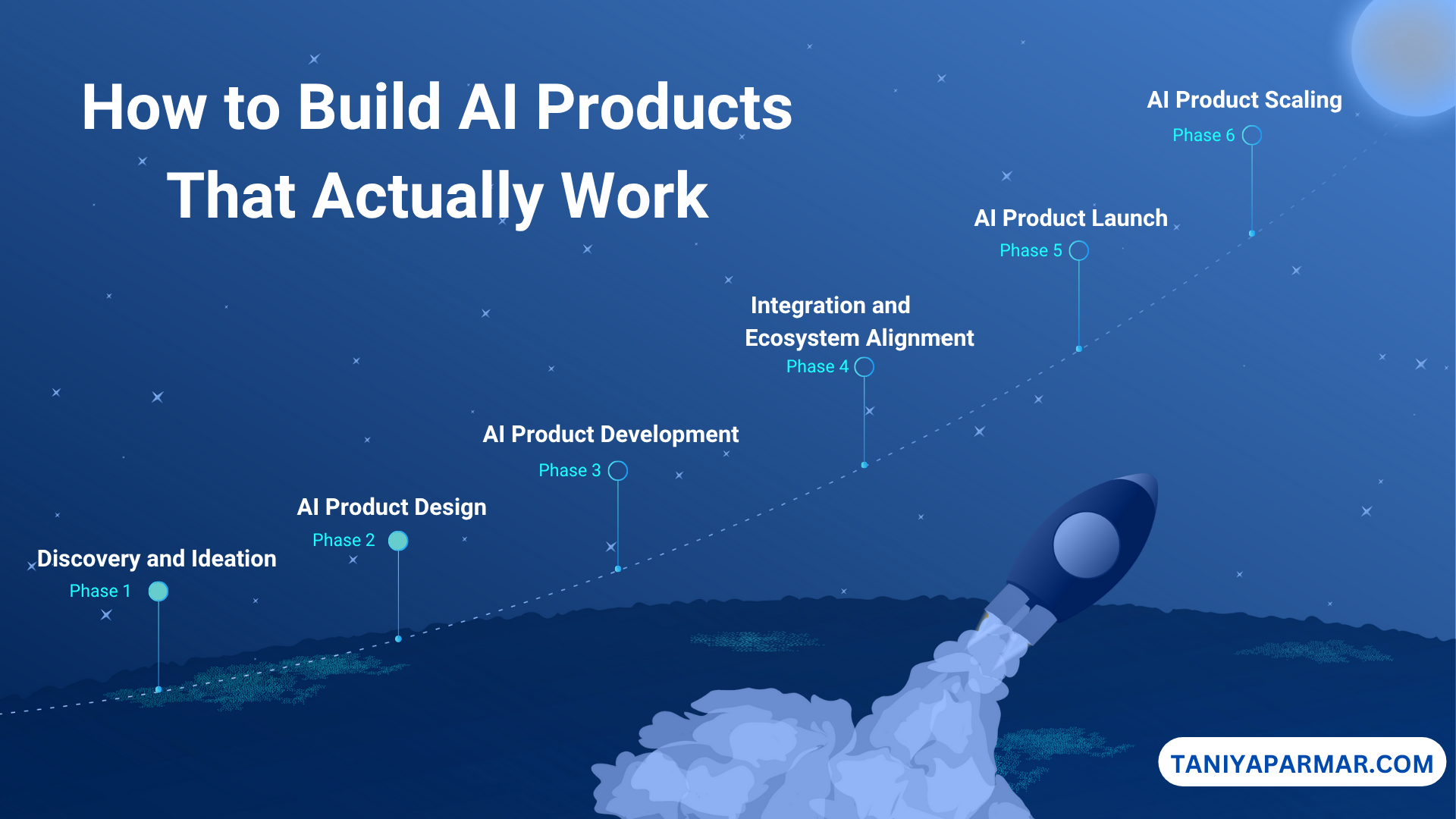Let’s be honest, everyone’s rushing to add “AI” to their products these days. Is it real innovation or helping you outrank your competitors? Not really. That happens when you blend cutting-edge tech and AI tools with genuine human insight. Whether you are developing standalone AI products, in-app AI products, or AI-powered platforms. Nailing the process makes all the difference. Here’s how the pros do it, including the messy bits most guides ignore.
1. Discovery and Ideation: Building the Foundation
You have an idea, but is it worth spending time and money on it? You can easily figure this out. If you do the following with the AI product idea to bring it to life.
- Listen First, Build Later: Identify pain points and opportunities through user interviews, surveys, and competitor analysis. Understand your audience’s environment, behaviors, and expectations to build useful AI products.
-
The Reality Check: Validate if the problem can be addressed effectively using AI. Assess technical feasibility, cost, and resource availability.
-
Define “Win”: Set clear KPIs and goals for both business and technical outcomes. It will help you in decision-making.
2. AI Products Design: Making the Blueprint
AI products fail when they feel like black boxes. Your job is to make complexity invisible.
- Problem First, Tech Second: Start with a razor-sharp problem statement. Validate it with real data, not just stakeholder opinions.
- Use Cases That Matter: Avoid “AI for AI’s sake.” Example: Don’t just build a chatbot; build one that actually cuts customer wait times by 40%.
- Empathy as a Feature: Map user personas. If your grandma wouldn’t get the UI, simplify it. Every. Single. Time.
- The Ethics Gut Check: Ask the hard questions early. Could our data introduce bias? How transparent are we about how this works? GDPR/CCPA isn’t red tape, it’s trust-building.
3. AI Products Development: Where the Rubber Meets the Road
This is where theory collides with reality. Embrace the messiness.
- Tool Choices That Won’t Bite You Later: NLP? Hugging Face or OpenAI might save months. Repli, Lovable, and FlutterFlow, etc., are your friends. Match the stack to the job.
- Data Pipelines: Your Secret Weapon: Garbage data = garbage AI. Build a robust collection and cleaning upfront. Cloud (AWS/Azure/GCP/Supabase) isn’t optional for scale. It is a must.
- Start early, Iterate Fast: Build an MVP (Minimum Viable Product). Use pre-trained models to test and validate. Here, Hugging Face is your friend, and Perfection is the enemy.
- Test Like the World Depends on It: Test with edge cases, noisy data, and worst-case scenarios. If it breaks in testing, it won’t survive the real world.
4. Integration and Ecosystem Alignment: Fitting Into the Wild
Your AI doesn’t live in a lab. It needs to play nice with others.
- Integration Ninja Moves: Ensure seamless integration with third-party tools or existing systems. If it breaks existing workflows, adoption tanks.
- Speak the Ecosystem’s Language: Sales AI? Plug into CRMs like Salesforce. Industrial AI? Talk to IoT devices. Fit matters more than brilliance.
- Security Isn’t a Feature, It’s the Foundation: Audit everything. One data leak can sink your product.
5. AI Products Launch: Controlled Burn, Not Wildfire
Go quiet before you go big. Premature scaling kills more AI products than bad code.
- Beta Test with Teeth: Handpick testers who’ll rip it apart. Track accuracy, speed, and frustration levels ruthlessly.
- Scale Smart: Dockerize. Automate deployments (CI/CD). Assume traffic will 10x overnight.
- Marketing That Cuts Through the Hype: Skip the “powered by AI” fluff. Show concrete results: “Our tool boosted conversion rates 22% for Company X.”
- Never Stop Watching: Post-launch is when real work begins. Monitor performance drift. Retrain models weekly. Stay paranoid.
6. Adoption and Change Management: Where AI Products Live or Die
If users do not trust or use your AI Product. Then you must know what you should be doing to make it right.
- Onboarding That Sticks: Create snackable tutorials. Host live Q&As. Meet users where they are.
- Support That Anticipates: Build a knowledge base before launch. Offer real human support channels.
- Feedback as Fuel: Collect feedback to prioritize future updates in the product. Even create a feature requests space and log them visibly.
7. Optimization and Maintenance: The Long Haul
AI products rot if neglected. Plan for perpetual care.
- Performance Vigilance: Automate drift detection. If accuracy dips by 2%, investigate now.
- A/B Test Relentlessly: Try small changes constantly. That tiny UX tweak might double engagement.
- Evolve or Die: Update quarterly at minimum. New research? Changing regulations? Adapt fast.
8. Scaling and Expansion: Growing Pains (The Good Kind)
Success creates new headaches. Be ready.
- Going Global? Localize language models and UI. Cultural nuance isn’t optional.
- Leveling Up Features: Once core adoption hits, layer in advanced capabilities that users beg for.
- New Markets, New Rules: Expanding to healthcare? Finance? Compliance becomes your #1 priority.
9. Sunsetting with Grace
Sometimes, killing a product is the right move. Do it professionally.
- The Off-Ramp: Give users ample notice. Offer data exports. Help them transition smoothly.
- Post-Mortem Wisdom: Document why it failed or succeeded. Document learnings from the product lifecycle to inform future projects.
Let me be your AI Product Manager
As an AI Product Manager, certified by IBM. I have successfully launched AI products in chaotic startups and complex enterprises. My focus is to help build AI products that work and solve real human problems. If you have an idea but do not know where to start. Just reach out, and first coffee’s on me.
